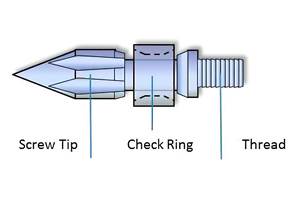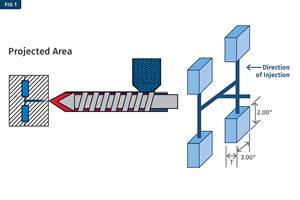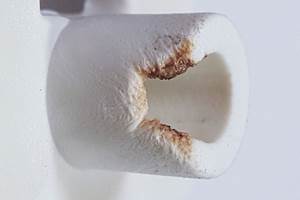New Material Cures LSR Molding Headaches
For some problems the solution is to be soft but also be strong.
For some problems the solution is to be soft but also be strong. That was certainly the case for one injection molder of liquid silicone rubber (LSR) and its customer, a producer of earplugs for swimming and hearing protection. McKeon Products, Inc., Warren, Mich., which reportedly invented the silicone earplug in 1962, recently came out with an advanced design that required a soft, flexible feel but also uncommon strength for such a low-durometer LSR material.
McKeon picked multinational LSR molder Silcotech North America Inc., Bolton, Ont., to produce the new product. The main production issue stemmed from the thin wall sections and multiple significant undercuts, which resulted in high scrap rates due to parts tearing while they were demolded.
After prototyping five different molds, Silcotech and McKeon chose an automatic 16-cavity slide tool with thin walls (0.25 mm) for the conical sealing flanges and thicker walls (5 mm) for the cylindrical handle. However, the undercuts on the sealing flanges resulted in high stretching loads on the material during demolding, so that parts broke and portions remained in the cavity, which hindered productivity.
Also, silicone plated out on the mold surfaces, requiring the tool to be removed from the press for cleaning every two weeks. That took 6 to 8 hr, not counting the time for mold cool-down before removal and heat-up once back in the press.
NEW LSR SUCCEEDS
Faced with the expensive option ($70,000 to $100,000) of again redesigning the tool to eliminate the undercuts, Silcotech opted instead to seek out a different LSR material that could withstand the stresses of part removal. The solution proved to be a new material commercialized last year by Shin-Etsu Silicones of America. Silcotech tested one of a new KE2004 Series LIMS (Liquid Injection Molding Systems) that are very soft—5 to 20 Shore A—without sacrificing strength.
The grade that proved right for the job was new KE2004-20, originally designed for baby-bottle nipples and said to have the highest tear strength on the market for a 20 durometer LSR. Its higher strength and outstanding release properties greatly reduced scrap generation during demolding.
According to Silcotech NA president Michael Maloney, “We needed a higher-tear-strength material, and Shin-Etsu’s KE2004-20 reduced our cycle time by 60%. It was a night-and-day difference.” Other LSRs had to be cured longer in the press to obtain suitable strength.
Shin-Etsu’s new LSR provided the same softness but higher tear strength to withstand demolding—
and did so in less than half the cure time of other LSRs.
Add to that the higher yield of good parts and reduced plate-out that requires less frequent mold cleaning, giving Silcotech a 100% increase in productivity.
Another processing advantage reportedly comes from the material’s relatively high viscosity for such a low-durometer material. While still easily pumpable, the higher viscosity is said to to provide more balanced mold filling and minimizes flash without sacrificing injection speed. Gravity also has less effect on filling a vertical tool. This is achieved via “dynamic viscosity”—i.e., the viscosity is high at low shear and lower at the higher shear generated during injection. This characteristic (common in thermoplastics) is seen in some, but not all, LSRs.
The accompanying table compares mechanical properties of KE2004-20 and competitive LSRs. Note that the cure conditions for the Shin-Etsu material follow a laboratory procedure designed to obtain more consistent results in ASTM testing with a cold compression mold. In typical production injection molding, KE2004-20 would be cured at 300 to 350 F for less than 1 minute and would need no post-cure.
| Comparison of 20 Durometer LSRs | |||
| SUPPLIER A | SUPPLIER B | SHIN-ETSU | |
| PROPERTY | LSR A | LSR B | KE2004-20 |
| SPECIFIC GRAVITY | 1.1 | 1.09 | 1.09 |
| VISCOSITY, PA-Sec | 170 | 250 | 625 |
| SHORE A HARDNESS | 20 | 20 | 22 |
| TENSILE STRENGTH, PSI | 1190 | 871 | 827 |
| ELONGATION, % | 810 | 1000 | 870 |
| TEAR STRENGTH, PPI | 103 | 57 | 207 |
| COMPRESSION SET, % | 14 | 65 | 15 |
| PRESS CURE | |||
| TIME, MIN | 5 | 10 | 10 |
| TEMP., F | 329 | 347 | 248 |
| POST CURE | |||
| TIME, HR | 4 | — | 1 |
| TEMP., F | 392 | — | 302 |
Related Content
Got Streaks or Black Specs? Here’s How to Find and Fix Them
Determining the source of streaking or contamination in your molded parts is a critical step in perfecting your purging procedures ultimately saving you time and money.
Read MoreIs There a More Accurate Means to Calculate Tonnage?
Molders have long used the projected area of the parts and runner to guesstimate how much tonnage is required to mold a part without flash, but there’s a more precise methodology.
Read MoreUse These 7 Parameters to Unravel the Melt Temperature Mystery
Despite its integral role in a stable process and consistent parts, true melt temperature in injection molding can be an enigma. Learning more about these seven parameters may help you solve the puzzle.
Read MoreBack to Basics on Mold Venting (Part 1)
Here’s what you need to know to improve the quality of your parts and to protect your molds.
Read MoreRead Next
Beyond Prototypes: 8 Ways the Plastics Industry Is Using 3D Printing
Plastics processors are finding applications for 3D printing around the plant and across the supply chain. Here are 8 examples to look for at NPE2024.
Read MoreSee Recyclers Close the Loop on Trade Show Production Scrap at NPE2024
A collaboration between show organizer PLASTICS, recycler CPR and size reduction experts WEIMA and Conair recovered and recycled all production scrap at NPE2024.
Read MoreMaking the Circular Economy a Reality
Driven by brand owner demands and new worldwide legislation, the entire supply chain is working toward the shift to circularity, with some evidence the circular economy has already begun.
Read More












